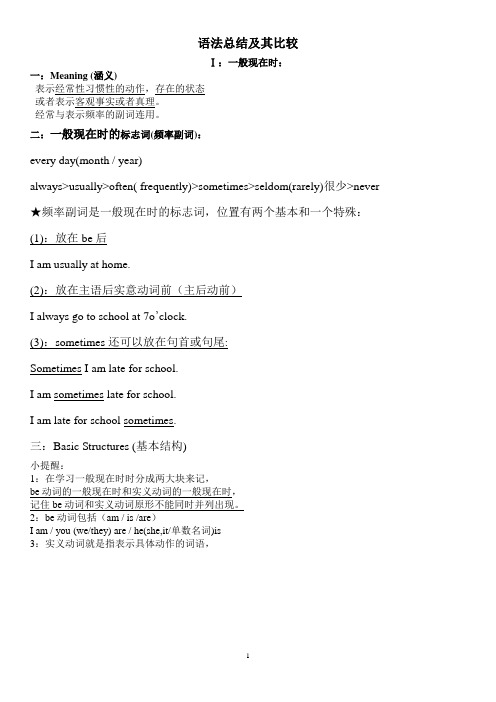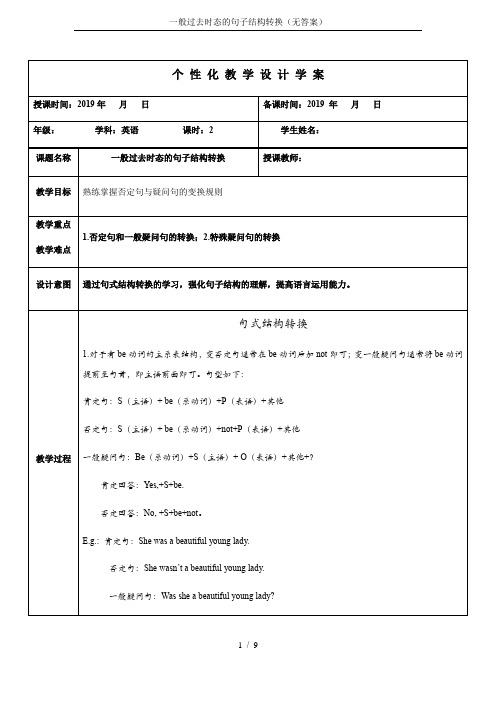句型转换结构图
- 格式:doc
- 大小:22.00 KB
- 文档页数:1

现在分词的变化规则1. 一般情况下,在动词后加-ing构成:work→working 工作sleep→sleeping 睡wait→waiting等待study→studying 学习read→reading 读talk→talking 谈话2. 不发音的-e结尾的动词去掉e后再加-ing:smile→smiling 微笑move→moving write→writing 写 come---comingleave ---leaving take ---taking bite ---biting have –havingwake---waking make---making dance----dancing ride----riding但是,若是发音的e结尾,则不能去e:see→seeing 看见agree→agreeing 同意3. 以重读闭音节或r音节结尾且末尾只有一个辅音字母动词,要双写末尾的辅音字母再加-ing:sit→sitting plan→planning pr efer→preferring run ---runningswim ---swimming shop ---shopping begin ---beginning stop---stoppingforget---forgetting cut---cutting get---getting hit—hittingset---setting fit---fitting dig—digging重读闭音节是指:这个动词是重读音节,同时单词的最后也是以辅音字母结尾的闭音节。
音节:1. 单音节:音标中含有一个元音;(单音节全是省略了重读符号的重音节)2. 双音节:音标中含有二个元音;(会有重读符号标在某个需重读的音节前)3. 多音节:音标中含有三个或三个以上的元音音标。
(会有重读符号标在某个需重读的音节前)音节:1.开音节1)以发音的元音字母结尾的单节。

2017.11.26“be going to" 结构一、“be going to"表示将要发生的事或打算、计划、安排要做的事。
它是一般将来时的一种表达形式,其后常有表示将来的时间状语.如:tomorrow, next week等.例如:We are going to play football tomorrow。
明天我们将去踢足球。
二、构成:be going to +动词原形。
在be going to 结构中,be随主语人称和数的变化而变化,而going to 固定不变。
例如:He is going to clean the classroom tomorrow.They are going to clean the classroom tomorrow。
三、句式变化:be going to 结构的句式变化都可在be上完成。
变疑问句时,将be提至主语之前;变否定句在be后加not。
例如:They are not going to have a picnic next week.下星期他们将不去野餐。
Are they going to have a picnic next week?下星期他们将去野餐吗?What are they going to do next week?下星期他们打算干什么?四、“be going to +动词原形"的用法。
1。
表示主语打算、安排在最近或将来要做某事或出现的某种状态。
这种主观意图,一般已做过事先安排,故其实现的可能性较大,其主语常是人.例如:We are going to swim next Sunday.下星期天我们打算去游泳。
(已打算好下星期天去游泳)2。
表示根据现有情况、某种迹象,判断将要或即将发生的动作。
此时不含有主观意图,只是表示说话人对客观事态发展的判断或推测,此时主语可以是人,也可以是物。
例如:Look! It’s going to rain。


语法总结及其比较Ⅰ:一般现在时:一:Meaning (涵义)表示经常性习惯性的动作,存在的状态或者表示客观事实或者真理。
经常与表示频率的副词连用。
二:一般现在时的标志词(频率副词):every day(month / year)always>usually>often( frequently)>sometimes>seldom(rarely)很少>never ★频率副词是一般现在时的标志词,位置有两个基本和一个特殊:(1):放在be后I am usually at home.(2):放在主语后实意动词前(主后动前)I always go to school at 7o’clock.(3):sometimes还可以放在句首或句尾:Sometimes I am late for school.I am sometimes late for school.I am late for school sometimes.三:Basic Structures (基本结构)小提醒:1:在学习一般现在时时分成两大块来记,be动词的一般现在时和实义动词的一般现在时,记住be动词和实义动词原形不能同时并列出现。
2:be动词包括(am / is /are)I am / you (we/they) are / he(she,it/单数名词)is3:实义动词就是指表示具体动作的词语,C: 第三人称单数形式的变化:动词的第三人称单数形式,是在一般现在时中当主语是he/she/it/单个的人名或者事物时后面有实义动词,实义动词要用第三人称单数形式。
主语若是I/you/we/they或复数名词,肯定动词用原形,否定疑问do来帮忙。
疑问把do提前去,do问do答否定do后加not,don’t放在主后动前。
主语若是he/she/it或单个人名肯定动后用三单,否定疑问does来帮忙否定does后加not,简写为doesn’t,放在主后动前疑问does提前去,does问does答,特殊疑问就在疑问句前加疑问词what什么how怎样where哪里when何时Ⅱ一般过去时一:一般过去时的涵义:一般过去时表示在过去的时间里发生的动作(实意动词)或者存在的状态(be动词),动作结束。


一般过去时的用法和结构一般过去时的用法及结构一般过去时用于表示过去某个时间发生的动作或存在的状态,也可以表示过去经常或反复发生的动作。
通常与表示过去的时间状语一起使用,例如yesterday,last week,last night,in 2003,two days ago等。
例如,昨天我六点半起床了。
XXX.一般过去时的基本结构为:肯定句“主语+动词过去式+其他”或者“主语+was/were+其他”,否定句“主语+didn’t+动词原形+其他”或者“主语+XXX其他”,一般疑问句“Did+主语+动词原形+其他?”肯定回答为“Yes,主语+did”,否定回答为“No,主语+didn’t”或者“Was/Were+主语+其他?”肯定回答为“Yes,主语+was/were”,否定回答为“No,主语+XXX’t”。
例如,我上周末打网球了。
我的学校郊游棒极了。
这个女孩昨天下午没玩电子游戏。
上星期五老XXX不高兴。
特殊疑问句的结构为:特殊疑问词+一般疑问句(顺序)?例如,XXX上周末干什么了?他去看了他的祖父母。
你昨天在哪儿?我在家里。
为了帮助记忆实义动词一般过去时的用法和结构,我们可以使用以下歌诀:“动词一般过去时,表示过去发生事。
谓语动词过去式,过去时间作标志。
否定形式很简单,主语之后加didn't。
谓语动词要还原。
疑问构成有规则,主语前面加did。
”过去式的构成有两种方式:be动词和实义动词。
系动词be的过去式有两种形式:was和were。
其中,was是am和is的过去式,were是are的过去式。
实义动词过去式的构成有以下几种规则:1.一般在动词末尾加-ed,例如walk→walked,play→played;2.以不发音e结尾的动词末尾只加-d,例如love→loved,decide→decided;3.以“辅音字母+y”结尾的动词,先将y变为i,再加-ed,例如study→studied,carry→carried;4.末尾只有一个辅音字母的重读闭音节,先双写该辅音字母,再加-ed,→ped,plan→planned。
存在句:又叫做“There be句型”,是一种表示“存在”的句式。
常见结构:“There + be + 主语+ 地点状语(或时间状语)”。
存在句的“there”要弱读。
存在句的句型转换:一. 肯定陈述句例如:There is a dictionary on the desk.(桌子上有一本字典。
)二. 否定陈述句例如:There isn't a dictionary on the desk.(桌子上没有字典。
)三. 一般疑问句例如:Is there a dictionary on the desk?(桌子上有一本字典吗?)四. 特殊疑问句例如:How many dictionaries are there on the desk?(桌子上有几本字典?)What's there on the desk?(桌子上有什么?)五. 反意疑问句例如:There is a dictionary on the desk, isn't there?(桌子上有一本字典,是吗?)存在句的谓语动词和助动词连用:例如:There have been many accidents in the past few weeks.(过去几个星期里发生了几个事故。
)存在句的数:在存在句中,只要紧靠“There be”的第一项不是复数,其谓语动词便可用单数形式。
一. 单数例如:There was a dictionary, some pictures books and some magazines on the desk.(桌子上有一本字典,几本图画书,还有一本杂志。
)二. 复数例如:There are two books on the desk.(桌子上有两本书。
)。
中考初中英语祈使句讲解及练习初中英语――祈使句一、概念:祈使句指的是表示命令、请求、建议或劝告的句子。
二、句型结构:1、肯定句:2、否定句:1. 肯定的祈使句(1)动词原形+其他Stand up, please. = Please stand up. 请起立。
(2)Be + n./adj/prep短语.Be a good boy! 要做一个好孩子!Be careful! = Look out! = Take care! 小心 / 当心!(3)Let + 宾语 + 动词原形 + 其它成分Let me help you. 让我来帮你。
Let’s go to school together. 咱们一起上学去吧。
2. 否定的祈使句(1) Don't + 动词原形Don't stand up. 别站起来。
Don't be careless. 别粗心。
Don't let them play with fire. 别让他们玩火。
(2)Let型的否定式有两种:“Don't + let + 宾语 + 动词原形 + 其它成分”和“Let + 宾语 + not + 动词原形 + 其它成分”。
Don't let him go. / Let him not go. 别让他走。
Let them not play with fire. 别让他们玩火。
(3)no开头,用来表示禁止性的祈使句。
No smoking! 禁止吸烟!No fishing! 禁止钓鱼!No photos!三、练习一. 用括号内所给动词的适当形式填空。
1.It’s an important meeting. _________________ (not, be )late.2.________________ (not,make) any nise! Your mother is sleeping.3.________________ (not, speak) with your mouth full of food and _________ (be) polite.4. ________________ ( not, talk) and ____________ (read) aloud.5._______________ (not,leave) your homework for tomorrow, Larry.6.________________ (look) out! A car is coming.7._______________ (give) us ten years and just see what our country will be like.二、单项选择1. The TV is too loud. Please________. A.turn it down B. to turn it down C. turn down it D. to turn down it2. _______ late again, Bill!A. Don't to beB. Don't beC. Not beD. Be not3. _______ cross the road until the traffic lights turn green.A. NotB. Won'tC. Doesn'tD. Don't4. Please help me carry it, ______?A. will IB. will youC. shall ID. shall we5. Don't make so much noise, ______?A. will youB. won't youC. shall weD. do you6. Do you know the girl ______under the tree?A. standB. to standC. standingD. stood7. Kate, _______ your homework here tomorrow.A. bringB. bringsC. to bringD. bringing8. ________ me the truth, or I'll be angry.A. TellingB. To tellC. ToldD. Tell9. I've kept the dog _______Maomao for a long time.A. NameB. namedC. namingD. to name10. Don't you know that _______ is good for our health?A. swimB. swimmingC. swamD. swims11 .Her doctor said: “________ work so hard”A StopB Don’tC Can’tD No14. ________him the secret, will you?A Don’t tellB Not to tellC Not tellingD No telling15. ________ in bed. It’s bad for your eyes.A Not to readB Don’t readC Don’t to readD Not read16. ________ Your child. We’ll look after him.A Not to worry aboutB Don’t worry aboutC Not worry forD Don’t worry with20.Please ________ look outside. Look at the blackboard.A notB don’tC aren’tD can’t三、句型转换1. Will you please read it again more slowly? (改为祈使句)_______ ________ again more slowly, please.2. If you don't listen to me, I'll go. (改为同义句)________ ________me, or I’ll go.4. The teachers often tell the students not to be careless. (改为祈使句)_______ _______careless, please.5. Please sit next to Nancy. (改为否定句)_______ _______ next to Nancy.6. Don't forget to turn off the lights, please. (改为反意疑问句)Don't forget to turn off the lights, _______ _______?7. If you move, you'll die. (改为同义句)_______ ______, or you'll die.二、英语书面表达专项训练2.如今,很多城市出现了一种绿色出行方式――共享单车(bike-sharing),它因环保、便捷而备受青睐,但同时也引发了一些问题。
There be 句型用法总结There be 结构是英语中陈述事物客观存的常用句型,表示“有”,其确切含义是“存在”there作为引导词,本身没有意义,用动词be的某些形式作为谓语动词,它的主语是用一些表示泛指或不定特指的名词词组,动词be和主语的数必须一致。
句子最后通常为表示地点和时间的状语.因此要表达“某个地方或某个时间存在什么事物或人”的时候常用“There be +名词+ 地点(时间)这一句型.例如:There is a great Italian deli across the street.穿过街道,有一家大的意大利熟食店。
There are some students in the dormitory。
在宿舍里有一些学生。
一、There be 结构中的主谓一致1。
当动词be后所接的名词是单数可数名词或不可数名词时,be 应该取单数is;当其后所接的名词是复数的可数名词时,be用复数are。
There's a man at the door。
门口有个人。
There is some apple juice in the bottle。
瓶子里有些苹果汁。
There are some strangers in the street。
大街上有一些陌生人。
2.如果There be 后面是几个并列名词做主语时,动词be的形式和最靠近它的那个名词保持数的一致。
There is an ashtray and two bottles on the shelf. 架子上有一只烟灰缸和两个瓶子。
There are two bottles and an ashtray on the shelf. 架子上有两个瓶子和一个烟灰缸。
二、There be 结构中的时态1。
There be 句型中动词be可以有一般现在时、一般过去时、将来时和完成时. There is no harm in trying.不妨一试。